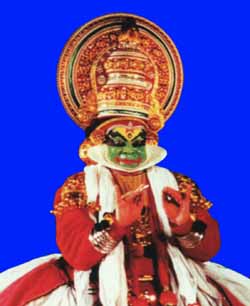Introduction
Kathakali is the most well known dance drama from the south Indian state of Kerala. The word Kathakali literally means “Story-Play”. It is known for its large, elaborate makeup and costumes. The elaborate costumes of Kathakali have become the most recognised icon for Kerala.

The themes of the Kathakali are religious in nature. They typically deal with the Mahabarat, the Ramayana and the ancient scriptures known as the Puranas. This is performed in a text which is generally Sanskritised Malayalam.
A Kathakali performance is a major social event. They generally start at dusk and go through out the night. Kathakali is usually performed only by men. Female characters are portrayed by men dressed in women’s costume. However, in recent years, women have started to become Kathakali dancers.
Kathakali has a long tradition. It dates back to the 17th century. It was given its present form by Mahakavi Vallathol Narayan Menon, who was the founder of the Kerala Kala Mandalam.
The actors rely very heavily on hand gesture to convey the story. These hand gestures, known as mudra, are common through out much of classical Indian dance.
Costume

The costume is the most distinctive characteristic of Kathakali. The makeup is very elaborate and the costumes are very large and heavy.
There are several kinds of costume. There are: Sathwika (the hero), Kathi (the villain), Minukku (females), and Thatti. These basic divisions are further subdivided in a way which is very well known to Malayali (Keralite) audiences. Each character is instantly recognisable by their characteristic makeup and costume.
The makeup is very elaborate. It is so elaborate that it is more like a mask than makeup in the usual sense. The materials that comprise the makeup is all locally available. The white is made from rice flour, the red is made from Vermilion (a red earth such as cinnabar). The black is made from soot. The colours are not merely decoration, but are also a means of portraying characters. For instance, red on the feet is used to symbolise evil character and evil intent.
Music
The music of Kathakali has some similarity to the larger body of South Indian classical music (Carnatic sangeet); however the instrumentation is decidedly different. Its local colour is strongly achieved by the use of instruments such as chenda, idakka, and shuddha madalam.
Conclusion
Is Kathakali classical? If we look at our benchmarks to see if it is classical, it only scores modestly. It is definitely old, but this is one of the least important of the criteria. It is not necessarily something that upper classes use to define their identity, indeed the opposite is probably true. Its most glaring deficiency is seen in its inability to transcend its attachments to the Keralite community. The average Indian (non-Malayali) has only a vague knowledge that it exists, and will live their entire life without ever even seeing a Kathakali performance. Therefore from a sociological standpoint it is probably more correct to call Kathakali “traditional” instead of classical.